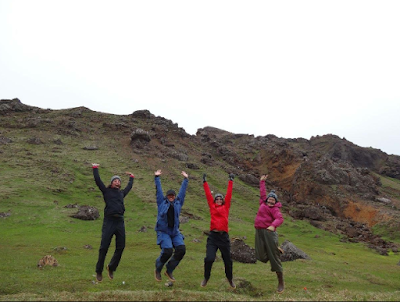Upon my initial arrival to the Hengill
Valley stream site, I felt as if I had stepped onto another planet. The rolling
hills, volcanic rock, boiling and steaming earth, and shades of green, brown,
and gold graced the landscape and captivated my attention. The smoky gray fog
glistened with mystery. The land is majestic. The cool, crisp, mesmerizing
breeze and running water quickly snapped me out of my trance and we proceeded
to prepare the experiments that will be our summer's work.
 |
| Hengill Valley, Iceland |
Fieldwork has always been my
favorite part of research, which is a clear indication of my love for the field
of ecology. Water? Sand? Mud? Count me in! Not only is our field site one of
the most beautiful places I have ever laid my eyes on, I find the unpredictable
weather, the physical and mental intensity of experimental innovation, and the
long days away from civilization, to be quite appealing.
 |
Photo by Jim Hood. Experiment where we are warming
a cold stream to 5 different temperatures, while also adding
nitrogen to some to see how the algal communities respond.
All using geothermal heat! |
So far, I have spent much of my time
in the field working with the team on the stream channel experiment. This has
been a big job, and it has been exciting to be a part of it. I have greatly
enjoyed learning some engineering, plumbing, and aquatic ecology from Dr. Jim
Hood (who arrived in Iceland in early May to get this experiment up and
running) from Montana State University. I am repeatedly mesmerized by the
geothermal activity of the Earth, and the way we can channel that energy to
experimentally vary water temperatures.
 |
Checking out the N-fixers in one of our warm streams with
Jill and Abbi. |
Back in the lab, we have been
prepping for the nitrogen fixation measurement procedures and practicing our
technique. We are anxious to get our sampling underway! Soon....
We will start that part of our work next week.

























